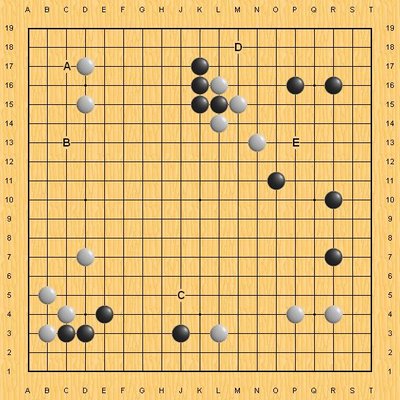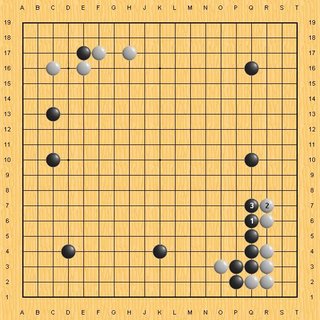GoBox is now available
Oh, bother! There's a lot of blogging to do, Blogspot is having technical difficulties, and I'm a bit short on time. Let's just keep this first post brief and add the rest as the week goes by.
Shortly after I returned from vacation, Pong Yen sent me an email that the GoBox was now available at the Yellow Mountain Imports website at a special introductory price of $98. I should have one hopefully in a couple of weeks.
In addition to the GoBox, YMI is now also selling goban sleeves for $9 and $8. There are two sizes available to fit either the regular table gobans or the slimmer bamboo table gobans. This is an inexpensive way to protecting your board when it isn't in use ... if that should ever happen.
Fuseki Quiz 12/20
Scoring of the previous Fuseki Quiz 11/20
(Jump to the last quiz!)
- A = 6
- B = 4
- C = 8
- D = 10, Black pushing with Q7 and, afterwards, with Q8 (see Ref.Dia.1) is playing on a grand scale. Especially in handicap Go, the solidity of Black's wall is attractive. White will have great problems trying to find a way to reduce this territorial framework. On the other hand, if White gets to play 1, 3, and 5 in Ref.Dia.2, Black won't get much territory here.
- E = 2
In Other News: Good Reads:
The Untied States of America: Polarization, Fracturing and Our Future
From Publisher's Weekly:
American history, both distant and recent, is troubled with violence and schisms that constantly threaten the foundations of the country. The country has endured a civil war, two world wars, slavery, genocide and now, of course, the raging battle between the red and blue states. Are we on the brink of dissolution? That's the question Enriquez poses in this fact-filled, statistic-laden book. For more than 200 pages, Enriquez, the founding director of the Life Sciences Project at Harvard Business School, gives readers as many reasons as he can for why America may be headed toward an un-united future.
I picked-up this book at the library just before my trip. It seemed rather interesting.
I recall back in my college History classes how fascinated I was about the Roman Empire, how long it had lasted, and how quickly it came apart. Back then, my professor had mentioned to our class that many of the countries that exist today will come apart and come together. The United States would be no exception. We have fifty stars on our flag today. Tomorrow, we could have more, or less.
The writing style will seem odd to some readers. One would think that it was laid-out like a huge marketing brochure. There are many one-sentence paragraphs and some whole sentences are presented in super-large or small fonts. I suspect that Enriquez was trying to make this book accessible to today's common audience that prefers to digest its information in soundbites. I didn't find the style to be a burden at all.
The first chapter of this book, short as it is, might turn-off readers if they don't have a rudimentary understanding of Economics. It is, however, one of the more important ones in my humble opinion as it outlines the financial pressures that drives the dissolution of nations.
The sixth chapter was particularly interesting to me as it outlined the political and socio-economic divisions within Mexico and how these could affect the United States as well.
One interesting historical snippet that I learned from this book was how the Reagan administration had tried to acquire Baja California from Mexico as part of a debt-restructuring deal. That would certainly have made a very visible change in the western profile of the US.









4 Comments:
Chiyodad, the book looks interesting, I'll check it out. I used to live in Baja California.
If you haven't read it, check out "Guns, Germs and Steel" by Jared Diamond, sounds like it may be a book you would find interesting.
Hello Peregrine!
Actually, I had both watched and read Diamond's "Guns, Germs and Steel". Now that Enriquez has rekindled my interest in the rise and fall of nations, I've added Diamond's "Collapse: How Societies Choose to Fail or Succeed" to my upcoming readings list.
Also on my future readings is The Annexation of Mexico which I'm hoping will give further analysis into the regional schisms which seem to be playing out in their elections today.
Man! I was with you, CD, when you chose C on Fuseki Quiz 11. The answer seems weird to me since reference diagram 1 seems to indicate that black's correct move is gote, which would leave white to start on reference dia. 2 in which black's gains come to naught.
And now on this quiz I don't know what to do either! In actual play I'd be liable to do something like F17 - and that's not even an option.
I want to get a foothold on the left side, but B looks like it'll just get pinched right away at C11 or something. Then black will be on the run to the middle and white will chase, building strength the whole way.
Um D and E both seem valuable. I think E secures a lot of territory but it just isn't aggressive. C seems like a bread and butter kind of move. Something that you'll want later but doesn't shake the earth right when you play it. 'A' seems like suicide, but maybe there is some kind of joseki for it? It could prep for the F17 move that I really want.
I think in the end I have to figure I can't make anything from A and go for E. Ugh, none of them appeals to me.
If you dug 'Guns, Germs and Steel' then I'll mention a couple of books I read about the same time, the three of which complement each other in my head:
The First Idea, by Greenspan and Shanker - This book is bombtastic. Even if you aren't digesting it in tandem with Guns Germs and Steel it's a quality read. Heavy stuff, though. It takes a while to get through. An exhaustive look at the concept that emotional development is the foundation for logical behavior.
The Prehistory of the Mind: The Cognitive Origins of Art, Religion and Science by Steven Mithen - This one is pretty neat, and really feels like Mithen is moving his field forward by connecting psychology and archeology - though I have no academic basis to judge. It is accessible to the lay person, but doesn't quite have that NYT Bestseller flavor. It's more hardcore.
These are both "how did early humans become modern humans" type books, rather than a "fate of nations" type thing or politics.
Do you think that the Mexican political situation is the result of some specifically Mexican history? I just figured it for more of the play between 'haves' and 'have nots' that must be universal.
Hello Adam,
Thanks for the reading suggestions. I'll need to add those to my list.
Mexico is often seen as being composed of three to four regions; the divides being created initially by geography (mountain chains) and ethnic origin (Aztec vs. Maya).
The growing divide seems to add socio-economics. The North is generally wealthy (or wealthier) while the South is generally less so.
In chapter six of his book, Enriquez divides Mexico into four regions and equates each to a different country (roughly by GDP and GDP per capita for comparison).
-North "NAFTA country", Pop. 14.3M, GDP/Capita of $8,549 = Chile
-Central Mexico, Pop. 40.7M, GDP/Capita of $6,174 = A compact Poland
-Indigenous Mexico, Pop. 10.4M, GDP/Capita of $2,740 = Ecuador
-The New Maya Pop. 5.1M, GDP/Capita of $6,081 = Tunisia
Enriquez also mentions in his book:
"Regional discontent with Mexico City and its centralized government contributed to the loss of half the territory in the mid-1800s."
Post a Comment
<< Home